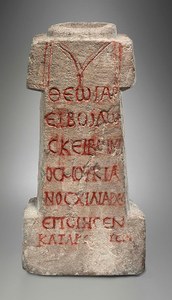Introduction
 Dura-Europos was founded at a strategic location high above the Euphrates River in ca. 300 BCE by one of the generals who succeeded Alexander the Great. The name Europos reflects that of a city in the founder’s Macedonian homeland, while Dura is an Assyrian word that describes a fortified place. During the following centuries the fortress grew into a Hellenistic grid-planned city.
Dura-Europos was founded at a strategic location high above the Euphrates River in ca. 300 BCE by one of the generals who succeeded Alexander the Great. The name Europos reflects that of a city in the founder’s Macedonian homeland, while Dura is an Assyrian word that describes a fortified place. During the following centuries the fortress grew into a Hellenistic grid-planned city.
In the late second century BCE, however, the city (and all of southern Mesopotamia) was taken by the Parthians, and the town was no longer in the center of the Seleucid realm, but on the western border of a massive Near Eastern empire. The Parthians introduced many new religious cults to Dura and controlled it for nearly 300 years. Dura changed hands a second time, in 164 CE when it was captured by the Roman emperor Lucius Verus. The town then thrived as a critical stronghold along the Romans’ eastern frontier until 256/7, when it was destroyed by the Sasanian Empire, successors to the Parthians.
For centuries, Dura-Europos was positioned at the commercial, political, and cultural intersection of the Mediterranean and Near Eastern worlds. Abandoned after the Sasanian sack, Dura-Europos remained virtually unexplored until its accidental discovery and then intensive archaeological investigation in the 1920s and ’30s. Archaeologists have revealed nearly a quarter of the city, including a synagogue painted with biblical scenes, one of the earliest Christian house-churches, and numerous public and private pagan shrines—discoveries that fundamentally altered our understanding of religious practice in antiquity.
The exhibition Edge of Empires vividly illustrates the pluralistic character of Dura-Europos during its final phase as a cosmopolitan Roman town with an urban landscape shaped by religious, linguistic, and cultural diversity. The objects on view, which are all on loan from the Yale University Art Gallery permit exploration of the fascinating and diverse people who lived in or passed through the city. The installation begins with a series of archival photographs of the early twentieth-century excavations and of objects that illustrate domestic life. Selections in the main gallery emphasize the international character of the Roman military; the breadth of languages spoken and written at Dura (Greek, Latin, Aramaic, Parthian, Middle Persian, Hebrew, Safaitic, and others); the importance of long-distance trade to supplying the town; and the great diversity of religions: pagan, Jewish, and Christian.
Edge of Empires: Pagans, Jews, and Christians at Roman Dura-Europos has been organized by the Yale University Art Gallery and the McMullen Museum of Art, Boston College. A version of the exhibition previously appeared at the McMullen Museum, with the title Dura-Europos: Crossroads of Antiquity. The ISAW presentation was made possible through the support of the Leon Levy Foundation. Additional funding was generously provided by the David Berg Foundation.
Image: Inscribed altar from the Temple of the Palmyrene Gods, Dura-Europos, 165–256 CE. Limestone, H. 73.7 cm, W. 36.8 cm, D. 27.9 cm. Yale University Art Gallery, Yale-French Excavations at Dura-Europos: 1929.385.